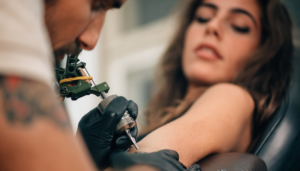In many societies around the world, tattoos and piercings are more than just forms of self-expression; they are symbols deeply tied to culture, tradition, and social acceptance. However, despite their growing popularity, numerous cultures maintain strong taboos against these body modifications, viewing them as inappropriate or even taboo. These perceptions are often rooted in historical beliefs, religious doctrines, or social hierarchies that have persisted over generations.
Understanding the origins of these taboos helps shed light on their significance today. While some communities embrace tattoos and piercings as part of their cultural identity, others associate them with negative stereotypes or social deviance. Navigating these differing perceptions requires sensitivity and awareness of the cultural context behind these practices, especially when traveling or engaging with diverse communities.
Historical Significance of Tattoos and Piercings
Historically, tattoos and piercings have served various roles across cultures. In many indigenous societies, body art was a rite of passage, symbolizing achievement, status, or spiritual connection. For example, some Polynesian tribes used tattoos to denote social rank, while certain African communities believed piercings offered spiritual protection.
Over centuries, these practices have often been intertwined with rituals and beliefs. During specific eras, tattoos might have been associated with criminality or rebellion, leading societal perceptions to become stained with negativity. These historical associations often still influence modern attitudes, especially in cultures where such body modifications were stigmatized in the past.
In some societies, body alterations were also viewed as markings of adulthood or nobility. Conversely, others considered tattoos and piercings to be signs of outsider status or disobedience, reinforcing social boundaries. These layered histories contribute to the complex view of tattoos and piercings today.
Religious and Spiritual Beliefs
Religious beliefs have historically played a crucial role in shaping perceptions of tattoos and piercings. In some faiths, body modifications are seen as disrespectful to divine creation, thus regarded as taboo. For instance, certain Christian communities consider tattoos as defiling the body meant to be a temple of the Holy Spirit.
Conversely, spiritual traditions in other cultures embrace tattoos and piercings as sacred rituals. Maori tribes in New Zealand, for example, view moko (tattooing) as an essential aspect of identity and spiritual heritage. Similarly, in Hindu culture, nose piercings symbolize marital status and spiritual beliefs, making them a vital cultural expression.
Religious anti-tattoo attitudes can sometimes lead to social exclusion or judgment, particularly in conservative communities. Understanding these religious values helps explain why tattoos and piercings might be discouraged or regarded as taboo in certain contexts.
Social Status and Class Dynamics

In many societies, body modifications historically signified social hierarchy and class distinctions. Tattoos and piercings could indicate an individual’s status, profession, or community role. For example, sailors, soldiers, or prisoners might have prominent tattoos associated with their experiences or rank.
However, in some contexts, body modifications have been seen as signs of lower social standing or marginalization. For instance, in certain cultures, tattoos associated with prisoners or marginalized groups are stigmatized, leading to social prejudices. Such associations often perpetuate negative perceptions of tattoos and piercings.
Modern social dynamics are shifting these perceptions, with tattoos becoming more mainstream and associated with fashion or personal identity. Still, the lingering class-based associations can create sensitivities, especially in traditional or aristocratic societies.
Professional and Workplace Taboos
Despite evolving attitudes, many workplaces maintain restrictions on visible tattoos and piercings. In conservative business cultures, body modifications are often viewed as unprofessional or incompatible with the corporate image. Employees may face social stigma or even discrimination based on their body art.
This professional taboo stems from longstanding ideas about decorum, cleanliness, and discretion in the workplace. In some industries, such as finance or law, visible tattoos are still considered inappropriate, limiting career opportunities for those with body modifications.
However, attitudes are gradually changing as diversity and inclusion initiatives promote acceptance. Some companies now adopt more relaxed policies, recognizing personal expression as part of individual identity, challenging traditional workplace taboos.
Cultural Misappropriation and Globalization

The globalization of tattoo and piercing styles has led to questions of cultural respect and misappropriation. When people adopt designs or practices from cultures they are not part of, it can be seen as disrespectful or superficial, especially if the cultural significance is ignored.
For indigenous communities, these practices are sacred and embedded within their spiritual and cultural identities. When outsiders appropriate symbols without understanding their meaning, it can cause offense and perpetuate stereotypes.
Globalization has also facilitated the exchange of ideas and styles, making body art more accessible worldwide. While this promotes cultural diversity, it also challenges communities to protect their heritage and prevent cultural exploitation or commodification.
Health and Hygiene Concerns
Health risks associated with tattoos and piercings have historically contributed to cultural taboos. In some societies, body modifications are viewed as dangerous or unclean, especially when procedures are performed improperly or without proper hygiene standards.
Traditional methods used in some communities lacked sterilization, leading to fears of infections, disease transmission, or other health complications. These concerns persist in regions where regulations are lax or where practitioners lack proper training.
Public health campaigns often aim to educate about safe practices, but lingering fears continue to fuel taboos surrounding body modifications. Understanding the science behind safe procedures can help dispel myths and promote informed decisions.
Conclusion
While tattoos and piercings have become increasingly popular around the world, cultural taboos continue to influence perceptions and acceptance in various societies. These beliefs are deeply rooted in history, religion, social class, and health considerations, shaping how different communities view body modifications.
Recognizing the cultural context behind these taboos is essential for fostering understanding and respect. As societies evolve and diversity becomes more celebrated, attitudes toward tattoos and piercings are gradually shifting toward greater acceptance. Navigating these differences with sensitivity can help bridge cultural gaps and promote inclusivity for all forms of self-expression.







